Welcome, Vibrato Pedal Lovers!
This article will show you five of the best Vibrato pedals ever made to give new color to your signal chain.
Here you will find everything you have to know before choosing your next vibrato pedal and how to customize a vibrato pedal to get the best sound out of it.
Without more delay, let’s go now to my selection of the best vibrato pedals.
Quick Overview
Our Top 3 Choices For Best Vibrato Pedals
Boss VB-2W Waza Craft Vibrato Pedal
The Boss VB-2 was originally released in 1982 but without great commercial success. It was discontinued in 1986 by BOSS, but that guitar effect pedal had its own distinctive sound and became sometime later a highly desirable rarity.
MXR M68 Uni-Vibe
MXR’s new compact M68 is an excellent FET-driven, analog chorus/vibrato that produces depth and characteristic effect.
The 5 Best Vibrato Pedals to Enhance Your Chain!
#1. Boss VB-2W Waza Craft Vibrato Pedal
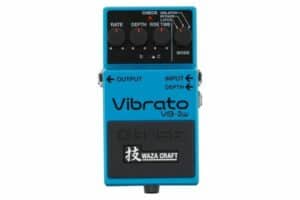
The Boss VB-2 was originally released in 1982 but without great commercial success. It was discontinued in 1986 by BOSS, but that guitar effect pedal had its own distinctive sound and became sometime later a highly desirable rarity.
The VB-2 was unique because there weren’t many stompboxes that provide real vibrato pitch modulation effects in those years. The most common pedals at that time were only tremolo and volume modulation pedals.
Luckily for vibrato pedal lovers, Boss has brought the VB-2 back to life with the Boss Waza Craft. It is certainly one of the best vibrato pedals of all times, and it gives all of the original sounds and adds a new custom mode and other features from the previous pedals of this line.
The Waza Craft and the original VB-2 are very similar in benefits and features except that the new Waza Craft has the following improvements:
- Located beneath the control knobs, it has a standard and custom (S/C) mini-toggle switch.
- Located beneath the Input jack, it has a 1/4-inch Depth jack for handling an expression pedal to control depth settings.
The rest of the controls are pretty identical:
- The rate and depth knobs adjust the speed and intensity of the modulation.
- Rise Time knob only works in Unilatch mode to vary the amount of time for the effect to rise to the selected depth.
- The switch allows for selecting three different modes: Latch, Bypass, or Unilatch.
- In Latch mode, the pedal operates as a normal on/off switch going from one set to another each time the footswitch is activated.
- In Bypass mode, the chip that generates the effect is bypassed in the signal chain.
- In Unlatch, the footswitch only turns the effect on for as long as the pedal is depressed.
If you are an old fashioned vibrato enthusiast, you are lucky. Because Boss has mass-produced the bucket brigade BBD chips with the introduction of the DM-2W, this chip is an analog vibrato circuit done in the early ’80s way.
Thanks to this amazing flexible customization, you can obtain the modulation that only a proper vibrato analog circuit can bring you. Although, the vibrato modulation waves are not as organic as a rotating speaker.
You’ll love this:
- You can control the depth setting using an optional expression pedal thanks to the VB 2W second jack on the pedal’s right side.
- You can obtain the Standard VB-2 voice, which replicates the original. Or you can make use of the Custom VB-2 deeper, darker, and more intense setting with the Standard/Custom switch.
- The four knobs will let you configure the new Waza Craft just as on an original VB-2.
- The Waza Craft is stout and reliable as most of the Boss stompboxes.
You might not like this:
- It may suffer from a lack of the voice of the original VB-2.
PROS
- Rich, deep, and unique vibrato tones that are exceptional from most modulation textures.
- The best of an analog vibrato.
- The solidity of Boss reliable pedals.
CONS
- Maybe it would be nice to have an expression pedal option for rate control.
#2. MXR M68 Uni-Vibe
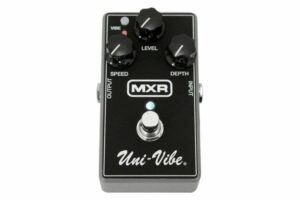
MXR’s new compact M68 is an excellent FET-driven, analog chorus/vibrato that produces depth and characteristic effect.
All admirably stuffed in a compact enclosure. The M68 gives an attractive authentic resemblance to the classic sound of the Uni-Vibe tones.
The M68 is one of the best vibrato pedals and has a simple control layout of three knobs and a small “vibe” button. Let’s see what you can do with all this staff:
- The speed knob controls the speed or frequency of the wave. It makes the vibrato mode more flexible and expressive. At slow speeds is where the vibrato is fairly pronounced.
- The depth knob delivers more range and flexibility over the effect. Using depth and speed can make you adapt the sound to adjust better to specific pickups, guitars, and amps.
- The level knob expands the pedal’s expressive range and tone and provides an extra depth and color.
- The small “vibe” button takes the chorus button’s place that’s side-mounted on the Roto-Vibe.
You can get to know the Uni-Vibe by starting with the default vibrato setting and slowly setting the depth and speed. Then you’ll hear the M68 complex and non-artificial tones. If you search for a more accentuated vibrato effect, the M68 can deliver some very unconventional tones.
The M68’s chorus textures are organic and rich. A good way to begin exploring the chorus sound is to set the speed at 10 o’clock and depth anywhere between 10 and 2 o’clock, and then play your Em. This way, you can obtain the same effect that David Gilmour achieved on his famous song “Take A Breath”.
You’ll love this:
- The Uni-Vibe delivers high quality and satisfyingly expressive vibrato and chorus.
- It presents a huge amount of tasteful and natural modulation effects at your fingertips in a compact package.
- The M68 provides a complete layout of controls to manage this pedal.
- A white LED pulses when the pedal is on, and a smaller red LED lights when the vibe effect is on.
You might not like this:
- Some tastes will find that the M68 hasn’t the most profound vibrato.
PROS
- The control knobs have glow-in-the-dark markings to handle them on a dark stage.
- Level control adds tone-shaping power and a boost.
- Organic modulation tones.
CONS
- At low speeds, the Vibe impact may be a bit subtle.
#3. TC Electronic Shaker
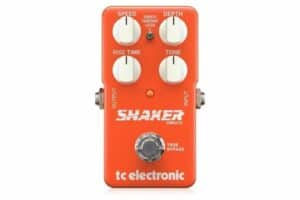
The TC Electronic Shaker Vibrato guitar pedal is designed to be fast and easy to use. You don’t have to worry about signal noises when the pedal is off because it comes with True Bypass.
The TC Electronic Shaker’s controls allow for a wide range of different vibrato effects, and it works excellently no matter what kind of vibrato you need.
The quality of sound is borderline perfect, and this is the model you are going to put on the top of your shopping list if you want the best of the best.
There are essentially four dynamic controls to work with and one switch that lets you choose different modes. This guitar pedal has four knobs, plus a three-way switch, and features selectable effects variations.
- RISE TIME: This knob controls the time it takes for the vibrato to reach the specified depth.
- SPEED: The SPEED knob determines the time between the peaks of the vibrato.
- DEPTH: The Depth knob controls the intensity of the vibrato.
- TONE: By adjusting the tone, you change the effects emphasis on high and low frequencies. Turn the knob fully clockwise and use the pedal in Latch mode to emulate a Leslie type effect.
The toggles switch handles the three modes: classic vibrato, TonePrint, or Latch.
- Vibrato: This is the regular mode. Here the BYPASS switch works as the effect on/off.
- Latch: In this mode, the effect is only active when you press and hold the BYPASS switch. As soon as you release the switch, the effect is turned off again.
- TonePrint: This mode allows you for uploading and uses different TonePrints configurations to your pedal.
The Shaker’s Latch function is able to add vibrato when and where you want it; the Shaker can be loaded with customized TonePrints.
You can import many new custom ‘tunings’ for the pedal thanks to the pedal USB connector. Then you can store them in a particular onboard memory slot selecting the TonePrint position of the pedal’s three-way switch.
The latch function is excellent for adding vibrato just where and when you want it. The Rise Time knob determines how long it takes for the vibrato to reach its specified depth to provide the full effect.
Inside the Shaker, there’s a DIP switch to manage the Bypass mode. This dip-switch switches between the default True Bypass mode and the Buffered Bypass mode:
- True Bypass: It gives absolutely no coloration of tone when the pedal is bypassed.
- Buffered Bypass: If you use several pedals on your board and a long cable between your guitar and the first pedal. The best solution would be to activate the buffered bypass in the first and last pedal of the signal chain.
You’ll love this:
- A cool effect that deserves to be heard as much as other modulation effects.
- The Shaker offers cool vibrato sounds and can do a pretty good rotary speaker emulation.
- It is designed to be fast and easy to use.
- The Shaker can be loaded with customized TonePrints.
You might not like this:
- Some guitar players still don’t recognize the full potential of TonePrint technology.
PROS
- Broad tonal range.
- Compact.
- Versatile.
- Responsive.
CONS
- Volume loss.
#4. Behringer Ultra Vibrato UV300
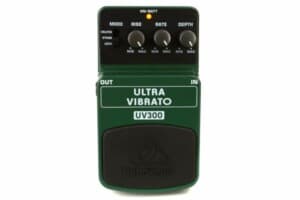
When you want a vibrato pedal that adds some cool retro sounding effect to your playing with a low budget, the Behringer Ultra Vibrato UV300 is the right choice for you.
The UV300 is a very affordable unit, and the main reason for it is that the housing is made of plastic rather than metal.
This may not be the best election for heavy stompers unless the UV300 plastic housing looks durable enough to last.
The control layout is simple and well organized at the top of the vibrato pedal. Let see how this pretty vibrato pedal works:
- The Rate knob controls the increase and decrease of the speed of the vibrato.
- The Depth knob adjusts the degree of variation in pitch.
- The Rise knob controls how quickly the vibrato kicks in.
- The Mode switch will let you modify how the footswitch functions.
- In Latched mode, the footswitch works like a simple vibrato pedal. So you click it on for vibrato and click it off to turn off the effect.
- In Unlatched mode, things change a little, and you will have to depress the pedal with your foot and the vibrato kicks in, take your foot off, and the effect turns off.
- In Bypass mode, the footswitch does nothing but this feature can help you prevent accidentally turning the effect on when you’re using another effect.
Behringer Ultra Vibrato UV300 is a full vibrato effect pedal that counts with very sensitive control knobs and a mode select switch that will let you manage different operation modes.
The UV300’s performance is balanced, maybe a little conservative, but genuinely based around the core vibrato effect.
You’ll love this:
- The unlatched mode will allow you to use the vibrato to enhance an individual phrase or part of a solo.
- The UV300 plays nicely with an overdrive and distortion pedal, and it will not color your tone when it is bypassed.
- The switching is smooth, the vibrato sounds great, and it doesn’t negatively impact your tone.
You might not like this:
- The housing can be a problem for heavy stompers because it is made of plastic.
- Those who are too picky about vibrato can feel a lack of performance with the UV300.
PROS
- Adds texture to your sound.
- Simple to operate.
- Very affordable.
- Adjustable latch mode.
CONS
- It hasn’t True Bypass, just Buffered Bypass.
- Not the best build quality.
#5. BBE Mind Bender
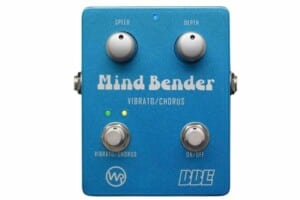
If you want to kill two birds with one stone, you may choose the Mind Bender. It is a dual-mode analog Vibrato/Chorus pedal.
The Mind Bender produces a wide spectrum of these two effects and rotating speaker effects thanks to the BBD (Bucket Brigade Delay) circuit.
It was based on two rare vintage guitar effects pedals: the Pitch Vibrato Boss VB-2 and the Way Huge Electronics’ Blue Hippo analog chorus effect pedal.
It brings the following set of features:
- Speed and depth controls.
- Vibrato/chorus mode switch.
- True hardwire bypass.
- A blue LED to indicate on/off status and pulse rate of speed control.
These two pedals in one earned the Guitar World Platinum Award, and it delivers consistent and reliable vibrato effects.
Mind Bender delivers the finest vintage analog vibrato experience without any difficulties. It has the BBE pedals’ consistency and ruggedness. These pedals are designed for demanding ears guitarists.
You’ll love this:
- Mind Bender will allow you to footswitch back and forth between the chorus and vibrato.
- It has two LEDs indicating which one you’re using.
- It is a nice-sounding analog pedal.
- It includes the AC adaptor.
You might not like this:
- The vibrato option may be of low quality for some demanding ears.
PROS
- True bypass.
- Satisfactory enclosure size.
- It has a five-year warranty.
CONS
- Vibrato low quality.
Best Vibrato Pedal Most Asked Questions
What is the Vibrato Effect?
Vibrato is a musical effect consisting of a constant, pulsating pitch used to add warmth to a note and expression to an instrument.
Vibrato is distinguished in terms of two factors:
- The amount of pitch variation or the extent of vibrato.
- The speed with which the pitch is varied or the rate of vibrato.
Vibrato is a useful technique for a guitarist to have in their arsenal. This technique can be achieved in both natural and technical ways via a vibrato pedal.
In the electric guitar world, vibrato belongs to the pitch shifter subdivision of the modulation effect family. Other pitch shifter pedals include tremolo and flanger.
These pedals are known for their audible variation in pitch of a musical note over time, defined by the speed and depth of that variation.
Tremolo and vibrato are two terms that are frequently confused. These effects are not widely used in the present, so it is quite common for some guitarists to have no experience with them.
Vibrato is a consistent modulation in pitch. So Vibrato pedals replicate this by giving you great flexibility in how you execute it.
How to Use a Vibrato Pedal?
As we have learned, vibrato is that sound you get when you start working the tremolo bar on your guitar. That sound effect is exactly what vibrato does for your signal.
There is a significant difference between vibrato and tremolo pedals. A vibrato pedal takes the input signal from your guitar and shifts the pitch of the note you are playing at that moment.
With a Vibrato Pedal, you can adjust the speed or frequency of the wave. But you also can change how far the pitch is going to be shifted.
Some of the most versatile vibrato pedals will also allow you to adjust the Rise. It determines the amount of time it will take the vibrato to go from the source pitch of the note played to the full de-tune of that note.
There are more modes of operation like Bypass, Latch, and Unlatch modes. Bypass lets you have your chain signal clean when it comes out of your guitar jack.
When using the Unlatch mode, the pedal will activate only as long as your foot is pressing that switch. On the other hand, Latch mode is the more classical mode you press once to activate the pedal and turn it off.
Where should the vibrato pedal go in the chain?
The ideal location to place modulation effects like flangers, rotary, tremolo, and vibrato is directly after the Overdrive/Distortion pedals and/or Compressor pedal.
This would be the best place because the sound tends to get dirty and lose definition when this kind of effect is distorted.
It is necessary to say that there are a few exceptions where distorting a flanger or phase shifter can sound really cool.
The main reason for this kind of placement is that when a modulation effects pedal like a flanger is placed in front of a distorted amp or overdrive pedal, it can create undesirable flanging effects.
For example, Van Halen generated all of his distortions from the amp and didn’t use distortion pedals.
What is the difference between Chorus, Vibrato, and Tremolo?
Chorus, Vibrato, and Tremolo effect pedal fall under the classification of modulation guitar effect pedals. That is why you’re going to hear a lot in common between tremolo, vibrato, and chorus. The reason for this is that the three effects are very similar indeed.
Vibrato pedals replicate a consistent modulation in pitch effect. They steadily increase and decrease in pitch. Vibrato pedals are designed mainly for guitar and bass to produce vibrato in the audio signal via analog and/or digital means. Vibrato is an audible variation in pitch of a musical note over time, defined by the variation’s speed and depth.
Tremolo is also a modulation effect, but it’s a modulation of volume as opposed to pitch. So Tremolo pedals only increase and decrease in volume. It rhythmically changes the volume of your signal. Within a Tremolo pedal, an LFO (low-frequency oscillator) is used to create a waveform used to turn the signal up and down.
A chorus effect pedal is a great way to create thicker sounds from a single signal. It works by creating a second copy of your signal, detuning it, and then playing it alongside your original signal.
This pedal can create the sound of two instruments playing simultaneously by taking your source signal, doubling it, and setting the second signal slightly out of tune and time with the first.
Vibrato and Tremolo modulation both affect your signal in a similar sort of rhythm, and due to that in-and-out of phase sound, you can understand why they could be easily confused.
Top Picks
It has come that exciting moment when I select the Top Picks from the article reviews. This section will tell you which Vibrato pedals are the very best according to my taste.
3rd Place: TC Electronic Shaker Vibrato Pedal
TC Electronic Shaker
The TC Electronic Shaker Vibrato Pedal comes with a True Bypass. Its controls allow for a wide range of different vibrato effects.
The Shaker has four knobs for Speed, Depth, Rise Time, and Tone, plus a three-way toggles switch for handling the classic vibrato, ToneShift mode, or Latch mode modes.
The pedal USB connector allows you to import many new custom ‘tunings’ for the pedal. Because of all this, I name the TC Electronic Shaker Vibrato Pedal my Second Runner-up.
2nd Place: MXR M68 Uni-Vibe
MXR M68 Uni-Vibe
The M68 is an excellent analog vibrato pedal. The Uni-Vibe can deliver very unconventional tones, and it provides a complete layout of controls to select chorus or vibe effects.
The speed knob controls the wave’s speed or frequency—the depth knob controls the vibrato power. The level knob expands the range and tone, and the small “vibe” button allows you to switch between the two effects.
The M68 delivers a huge amount of tasteful and natural modulation effects thanks to its high-quality chorus and vibrato effects. The glow-in-the-dark knobs allow users to handle this pedal on a dark stage. So, I name the Uni-Vibe as my Runner-up.
Winner: Boss VB-2W Waza Craft
Boss VB-2W Waza Craft
With the Waza Craft Vibrato, Boss is back to life with the original sounds of the old VB-2 pedal. But Boss added a new custom mode and a complete set of controls to handle this beautiful vintage vibrato pedal.
The Rate knob controls the modulation speed. The Depth knob controls the intensity reached by the effect. The Rise Time knob varies the amount of time to rise. And the three positions switch lets you select between Latch, Bypass, or Unilatch modes.
This pedal brings a bucket brigade BBD chip that will let you obtain a true vibrato circuit modulation. It will allow you to get the Standard VB-2 voice, plus the Custom more intense setting with the Standard & Custom mini-toggle switch.
Thanks to all these benefits, I want to name the Boss VB-2W Waza Craft Vibrato pedal the best vibrato pedal you can get.
Conclusion
We have learned some amazing things about vibrato. You know now that it belongs to the pitch shifter subdivision of the modulation effect family and that effects as tremolo, chorus, and flanger are between that pitch shifter pedals too.
In this article, I made an effort to show you five of the greatest vibrato pedals ever made to give new color to your effects chain. I also answered some of the most asked vibrato pedal questions.
This article was made to help you find the best vibrato pedal available on the market. I hope you have enjoyed the article and that you can judge now which one is the best option for your needs.


